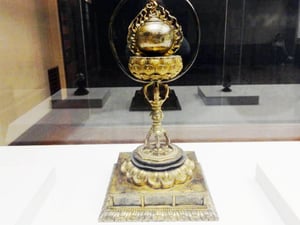Through masterpieces of metalwork from the Nara era to the Edo era, you can see shaping techniques such as casting and forging, decorating techniques such as plating, engraving, and cloisonne, and the shaping features of each era.
In the Edo era, the culture of the townspeople bloomed in addition to the samurai, and various living furniture items were produced in the field of metalworks against the background of the relatively stable society and economic development. Detailed technique using various materials such as gold, silver, copper, brass, iron
The engraving is meant to carve metal with a crown. Made from metal such as platinum, gold, silver, copper, brass, iron, aluminum, tin as the main material. It is a technique mainly for producing decorative (jewelry · accessories) and decorative brackets such as buddhist furniture and furniture.
Currently, things to be manufactured using metal are roughly divided into three categories. “Engraving”, “forging” and “casting” described below. In addition to that, there are several ways of calling it for classification such as “plating” and “jewelry”.
Engraving – a technique of engraving with scallops and file, shaping it into the intended shape, and putting patterns, patterns, letters etc on the surface.
Forged gold – a technique for shaping a metal into a shape intended by using a hammer, an anvil, an armor, a bird mouth, a bird’s leg, and the like. Mainly production of swords and objects. Including drawing and stamping.
Casting (casting) – A casting technique that makes a mold with soil and sand, pours the melted metal and creates a work. Small articles such as rings and big ones are bronze statues and Buddha statues.
Other sheet metal processing – Make box objects etc by cutting, bending and brazing.
Engraving technique
As a technique of engraving, there are watermarks, carvings, launchers, inlays, and carvings and inlays are further divided into several kinds. Moreover, it is also various for each use according to use.
Watermark – Cut out the metal ingot according to the design with a saw or saw or carve out.
Carving – Use gauze to carve the metal ingot and put in the designs and letters. There are many types such as hair styling, one-piece cutting, etc., and those that make a striking approach similar to a stamp such as a kick stone.
Launch – After extensive launching from the back of the metal, you can produce from the relief-like paintings to the figurines by pressing down the details from the table.
Inlay – a technique to engrave the grooves of the design intended for the bare metal of the main body and fit another metal. There are several inlay techniques, such as a method of fitting a large amount of ingots called this inlaid eye and inlaid cloth inlaid gold leaf or gold thread on the surface with fine eyes on the surface of the metal.
Horyuji Temple dedication As a representative work of the treasure, famous Long-necked water bottle, gold-cranked stone incense incense burner, carpentry work such as sea mirror etc. will be exhibited.
Bronze Burning Fire Burned Shaped Bulge Container Kamakura Era / 13th – 14th Century Buddhism is solemnly to decorate the Buddhist and the indoor space, and the decorative items used for this purpose are collectively referred to as solemn tools. Here it is a savage solemn which pays a stupidity like a shrine container, a dojo altar in Esoteric Buddhism.
Bamboo utensil is a sounder that strikes in a Buddhist ceremony. In addition, Kanji bells are swung in the Esoteric Buddhist practice, in particular. Many of these are made of copper-based metals, sharp and clear sounds peculiar to metals have a great effect in increasing the religious atmosphere.
Hamamatsu Figure Hirakado Ashiya Muromachi Period · 15th century.The tea ceremony hut is one of the most important tools in the art of tea ceremony which developed its own unique development in Japan. Although the use of robust iron for boiling has been done in the past, in tea ceremony furthermore aesthetic sense in the casting skin and hue of the material iron.
Tokyo National Museum
Tokyo National Museum collects and preserves cultural assets spanning the Toyo region widely, mainly in Japan as a comprehensive museum in Japan, for public viewing, and conducts survey research and education dissemination project etc. related to this , Aims to preserve and utilize cultural properties that are valuable national assets.
From April 1, 2007, the National Museum belonging to the National Museum of Japan and the National Institute for Cultural Properties to which the National Museum of Japan belongs were integrated, and the “National Institute of Cultural Properties” was launched. We will promote the preservation and utilization of cultural properties, which are precious national assets under the new corporation, more efficiently and effectively.

















